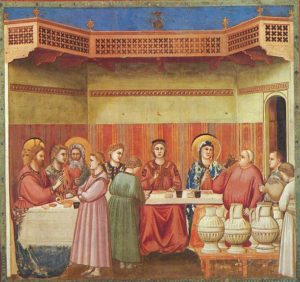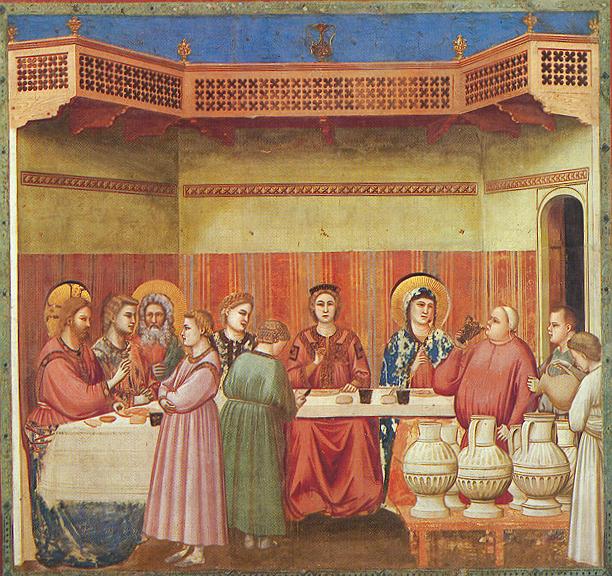N.B.: I am in the Holy Land at this time. As my travel schedule is heavy, I am republishing some articles about life in Jesus’ day. I hope you will enjoy reading (or re-reading) them as much as I did.
 The word family had a wider meaning both in Aramaic and in Hebrew than it does in English. The Hebrew, ah, and the Aramaic, aha, could be used to refer to brothers, sisters, half-brothers, half-sisters, cousins, and even other near relations. Extended family networks were both insisted upon and essential for survival. It was every Jewish person’s duty to maintain and depend upon these ties.
The word family had a wider meaning both in Aramaic and in Hebrew than it does in English. The Hebrew, ah, and the Aramaic, aha, could be used to refer to brothers, sisters, half-brothers, half-sisters, cousins, and even other near relations. Extended family networks were both insisted upon and essential for survival. It was every Jewish person’s duty to maintain and depend upon these ties.
Marriage – Marriage, of course, is the heart of family. The very first direction that God gave to Adam and Eve was that a man should leave his father and mother cling to his wife, that the two should become one, and that they should increase and multiply. Ancient rabbis said that a man wasn’t really a man at all until he did so. However, especially by the time of Christ, there were some men and women who lived celibate lives so as to be free to serve God; by studying the Torah, teaching, or engaging in some great work for God’s people. Jesus and Paul seem to have been in this category. Jesus praised those who did so in Matthew 19, as did Paul in 1 Corinthians 7.
In the earliest years of Israel, there seems to have been some tolerance for polygamy, despite the fact that it was a departure from what God had set forth. Many overlooked it, given the urgent need to grow the family of God, the chosen people. Men were often lost in war, which led to more women than men looking for a spouse. Generally, only wealthier men could afford to have more than one wife. Although the Bible does not explicitly condemn polygamy, it does demonstrate that polygamy often led to intractable troubles, sometimes between the women involved, but other times between their sons (particularly when it came to inheritance rights). By the time of Jesus, polygamy seems to have disappeared among the Jews. There is simply no mention of the practice in the New Testament. Jesus summoned the men of his day to love their wives and specifically prohibited other Mosaic leniencies in marriage. He re-proposed God’s original plan of one man for one woman till death do them part.
Call to marriage and engagement – Marriage took place at a young age for the ancient Jews. Most rabbis proposed 18 as the most appropriate age for men to be married, but it wasn’t uncommon for them to be younger, especially in times of peace. Young women were married almost as soon as they were physically ready, approximately age 13.
In most cases, marriages were arranged by the respective parents. However, arranged marriages were seldom forced on young people who had absolutely no attraction to or interest in each other. Nevertheless, the view in the ancient world—and even in many places today—was that marriage was not so much about love and romance as it was about survival. Further, it was not merely the individuals who were married; the two families came together in mutual support. Beauty and romance, while considered pleasant things, were noted to be passing. Life and survival had to be based on sturdier foundations.
When a future bride had been chosen for a young man, either by his parents or more rarely by himself, there followed a period of one year called “betrothal.” During this time the couple still lived apart while delicate, often-protracted negotiations occurred between the families regarding dowries, etc. The groom or his family paid the dowry to the father of the bride as compensation for the loss of a working member of his household. It was also understood that some money should be set aside for the woman to protect her in the event of her husband’s premature death.
Marriage ceremonies – At the conclusion of the betrothal period, when all the agreements were signed, the wedding could occur. Weddings of that time typically extended over five to seven days. Autumn was the best time for marriages because the harvest was in, the vintage was over, minds were free, and hearts were at rest. It was a season when the evenings were cool, making it pleasant to sit up late at night. In small villages, the entire community would usually gather to celebrate.
On the evening before the first day of the wedding feast, the bridegroom, accompanied by his friends, went to fetch his betrothed from her father’s house. He would wear particularly splendid clothes and sometimes even a crown. A procession was formed under the direction of one of the bridegroom’s friends, who acted as master of ceremonies and remained by his side throughout the rejoicing.
Having been fetched, the beautifully dressed bride joined in the procession, carried in a litter. Along the way people sang wedding songs drawn from the Song of Songs in the Bible: Who is this coming up from the wilderness like a column of smoke, perfumed with myrrh and incense made from all the spices of the merchant? (Song of Songs 3:6) When the procession reached the bridegroom’s house, his parents uttered a traditional blessing, drawn from Scripture and other sources. The remainder of the evening was passed in games and dancing, with the bridegroom taking part. The bride, however, withdrew with her friends and bridesmaids to another room.
The next day the great wedding feast came. Once again there was general rejoicing and a sort of holiday in the village. Toward the end of the day there was a meal; men and women were served apart. This was a time for the giving of presents, etc. The bridesmaids stood around the bride, who was all dressed in white; there were usually ten of them. The bride sat under a canopy while traditional songs were sung and blessings recited. In the evening the groom arrived, and while the exact ritual words are not certain, there seems to have been a dialogue between bride and groom, which is recorded in the Song of Songs: The bride said, Let him kiss me with the kisses of his mouth—for your love is more delightful than wine. Pleasing is the fragrance of your perfumes; your name is like perfume poured out. No wonder the young women love you! Take me away with you—let us hurry! Let the king bring me into his chambers (Song of Songs 1:2-4). The groom responded, Arise, come, my darling; my beautiful one, come with me. My dove in the clefts of the rock, in the hiding places on the mountainside, show me your face, let me hear your voice; for your voice is sweet, and your face is lovely (Song of Songs 2:13-14).
Now that the couple was together, all the men and women in attendance were together as well. Religious leaders imparted blessings on the couple, who were now together under the canopy. The words of these blessings are not known and seem to have varied. After these blessings came the evening feast.
Later on that first evening, the couple retired and the marriage was consummated. The celebration often continued for several more days; the couple did not go on a “honeymoon” but remained for the duration, sharing in the merriment.
The family – The concept of the strictly nuclear family living completely independently was largely unknown in the ancient world. That said, among the Jewish people each family was considered an independent unit. The father was considered the head of his household. Families did not exist in clans, in which all the families (including the fathers) were under the authority of a clan leader or patriarch. Such a system was more common among the Arabs.
Among the Jewish people, the father had absolute authority over the household. So absolute were his rights that he could even order members of his family put to death or sell his children into slavery. However, by Jesus’ time, selling children into slavery was unheard of and the death penalty was extremely rare—only inflicted with the agreement of other members of the village. Roman government actually forbade Jewish authorities from exacting the death penalty, reserving all such cases to itself.
Along with the many rights enjoyed by men and fathers in Jewish family life, there were also great responsibilities. A man was expected to provide his wife and children with all of their basic needs. Wives often referred to their husbands as lord (Baal) or master (Adon).
Wives and mothers had very few legal rights but a lot of practical authority in the home. One recourse she did have was to her father, who might rebuke her husband if he did not properly care for her. However, most men ensured that their wives were provided with the basics of life; in addition, they enjoyed seeing them well-adorned.
Wives did an enormous amount of work and their husbands depended on them. They prepared the meals, fetched the water, baked the bread, squeezed the oil, made the butter, tended the animals, and of course cared for the children. Most men knew that they utterly depended on their wives, and wives knew that they knew this.
Wives often generated extra income for the household by sewing and selling surplus oil and other food products. While some marriages were strained, most couples developed a loyalty based on mutual need.
Children – Jewish law and custom commanded from children absolute respect, honor, and reverence for both their father and their mother. They were also expected to care for their parents in their old age.
Children were greatly desired; large families were very common. Barrenness was considered a great curse and many Scriptures speak to the blessing of children. Clearly children were helpful with the household and field tasks, and later on they provided “social security” for their aging parents. Several generations of families usually lived in the same town, providing a good support system. The Jewish family was strong and was admired by the pagans, whose families by this time were in the kind of disarray we see today in the post-Christian West.





